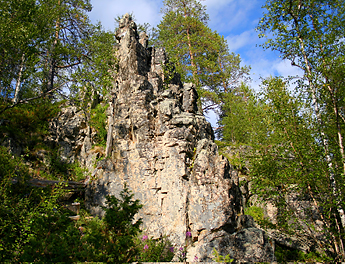Seidas are holy places (Bálvvosbáiki) related to ancient Sámi culture. There are mentions in writing about the Sámi people worshipping trees and rocks dates back to the 16th century. Seida worship became less and less important and were even destroyed when Christianity spread in the 17th and 18th centuries. These places of worship were believed to be the home of Gods, spirits and elf folk. Seidas were often made of wood or stone. Seida rocks are typically individual, unusually shaped or coloured natural rocks. Most seida rocks in Lapland are noticeable landmarks and clearly stand out in their environment. They are found on shores of rivers, on the slopes of the fells and near paths where Sámis used to walk with their reindeer. In lake Inari there is an island, Ukko, which is also a seida for sami.
Old Sámi religion was based on an animistic ideology, according to which everything in the nature has a spirit. In the hopes of favourable conditions, people offered sacrifices to the nature-dwelling spirits. The most important deity was Ukko, Äijih. The Finnish word Ukko derives from the word referring to thunder, ukkonen (like Torus, Thor). Ukko’s wife was Akka (Ákku or grandmother in Sámi). Other important Gods included the sun, i.e., Päivä (“Day”), as well as the moon, wind and water Gods. In pre-Christian Sámi culture, there was no term referring to religion. The seidas, deities and their worship were a natural part of people’s everyday life.
People used to visit seidas to honor the nature, but specially if health difficulties or other problems occurred.
 Wooden seidas have appeared mostly in wooded areas, on the shores of good fishing waters. They have often been shaped by cutting the lower branches of trees or lifting a block of wood or a tree stump into an imposing position. At times, people carved features of human faces or figures in the wooden seidas.
Wooden seidas have appeared mostly in wooded areas, on the shores of good fishing waters. They have often been shaped by cutting the lower branches of trees or lifting a block of wood or a tree stump into an imposing position. At times, people carved features of human faces or figures in the wooden seidas.
Also fells, hills, steep cliffs, unusual gorges and saivo lakes could have served as holy places. There are many place names in the North referring to the holiness of the place and its possible use as a place of worship. Fishing seidas were usually located by waterways, sometimes even in the water. The seidas located on fells and hills have been used by deer hunters and reindeer owners.
Every village (siida) in Lapland and several families also had their own seidas. A seida dedicated to the God Ukko stood behind many Lapp “kota” huts. The most important sacrificial ceremonies were related to turning points in the annual cycle. like midsummer or autumn, as well as the traditional rites in people´s lives, such as childbirth.
When a man set out to go deer hunting or fishing, he promised a share of his catch to the seida to ensure hunting and fishing luck. When he returned to the seida he offered the best parts as thanks; like bones, horns, fish or pieces of fish. The offerings were also meant to keep the seida in good mood. Sometimes the seida was even given spirits, tobacco, iron or money.
 Some Sámi people think you should be ware of seidas and other sacred places, because of the curse, illness and enchantment that could be transported over to visiting people. Seidas also demand gifts from the visitors and you should not go near the place if you do not bring what the seida wants.
Some Sámi people think you should be ware of seidas and other sacred places, because of the curse, illness and enchantment that could be transported over to visiting people. Seidas also demand gifts from the visitors and you should not go near the place if you do not bring what the seida wants.
Many seidas have been forgotten over time, but several holy places have become important attractions of cultural and historical significance, and their history is kept alive in stories and legends.
Here you find information about a few seidas and mysterious Saivo lakes in Lapland, if you dare to visit them.



